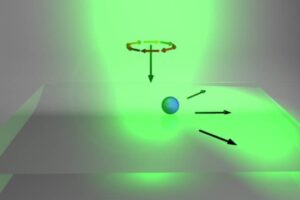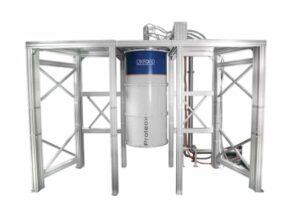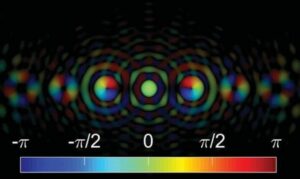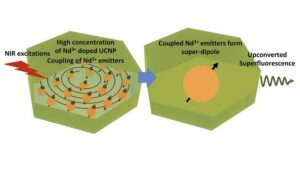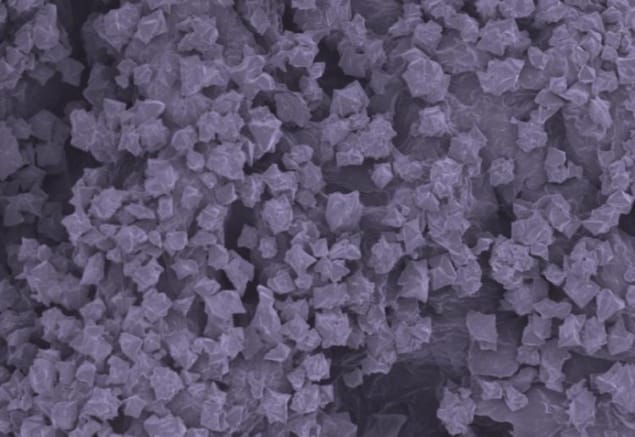
A textile coated with metal-organic frameworks (MOFs) could make an efficient anti-nerve agent material, according to experiments by researchers at Northwestern University in the US. The MOFs, which are based on zirconium, could act as catalysts to degrade chemical warfare agents such as VX and soman (GD) much faster than existing technologies, which are based on activated carbon and metal-oxide blends. The composite material, which might be used in protective suits and face masks for soldiers on the battlefield, does not require liquid water to work either, as previously thought.
MOFs are periodic nanoporous crystalline frameworks made from metal ions or clusters coordinated to organic ligands. The high surface area that comes from their porous structure means that they can be used in a host of applications, from sensing to gas separation and storage and catalysis.
Recent research has also revealed that the nanopores can effectively capture chemical warfare agents (CWAs) and then degrade them in a catalytic hydrolysis reaction. A team led by Omar Farha has now found that MOFs can continue to degrade these lethal chemicals, even when they are coated onto textile fibres.
MOFs can absorb enough water from the ambient humidity
Although the chemical degradation reaction requires water, the researchers say the nanopores in the MOFs can supply the needed water by absorbing it from ambient humidity. This will make it easier to deploy filters and other anti-nerve agent equipment based on this material in the field, Farha explains.
In their experiments, the team studied a Zr-based MOF with the chemical formula [Zr6O4(μ3-OH)4(OH)6(H2O)6(BTC)2]·nH2O (more commonly known as MOF-808). They began by applying a solution containing this material and polyethylenimine (PEI) to strips of cotton fabric. After allowing the fabric to dry overnight, they exposed it to DMNP, a nerve agent simulant commonly used in academic research labs. These tests showed that the MOF/PEI composite degraded DMNP even in the absence of water.
Fabric is durable and remains active
Farha and colleagues also tested the material’s durability. They found that the MOF remains securely adhered to the cotton and retains its crystallinity even when immersed in water and agitated for 24 hours. The composite’s catalytic activity also remains high after being exposed to ambient air for 100 days. In a final series of tests, they found the material retains its catalytic activity when exposed to sweat, atmospheric carbon dioxide and pollutants such as octane – environmental and physiological conditions similar to what a soldier might face on the battlefield.

Designer metal-organic frameworks grow on graphene
The researchers, who report their work in the Journal of the American Chemical Society (JACS), hope their material will one day replace existing anti-CWA technology – namely activated carbon and metal-oxide blends, which react more slowly to nerve agents. Ultimately, they would like to create an improved MOF composite that instantly detoxifies these agents. “We are also interested in designing fabrics that can degrade multiple agents at the same time,” Farha tells Physics World.
- SEO Powered Content & PR Distribution. Get Amplified Today.
- PlatoData.Network Vertical Generative Ai. Empower Yourself. Access Here.
- PlatoAiStream. Web3 Intelligence. Knowledge Amplified. Access Here.
- PlatoESG. Automotive / EVs, Carbon, CleanTech, Energy, Environment, Solar, Waste Management. Access Here.
- BlockOffsets. Modernizing Environmental Offset Ownership. Access Here.
- Source: https://physicsworld.com/a/nanomaterial-coated-fabric-destroys-chemical-warfare-agents/
- :has
- :is
- :not
- 100
- 24
- 90
- a
- academic
- academic research
- According
- Act
- activated
- activity
- After
- Agent
- agents
- AIR
- Allowing
- also
- Ambient
- American
- an
- and
- applications
- Applying
- ARE
- AREA
- AS
- At
- atmospheric
- based
- Battlefield
- BE
- began
- being
- blends
- BTC
- by
- CAN
- capture
- carbon
- carbon dioxide
- catalysts
- chemical
- chemicals
- colleagues
- comes
- commonly
- conditions
- continue
- coordinated
- could
- create
- day
- Days
- deploy
- designing
- destroy
- does
- dry
- durability
- easier
- effectively
- efficient
- either
- enough
- environmental
- equipment
- Even
- existing
- experiments
- Explains
- exposed
- fabric
- fabrics
- Face
- face masks
- faster
- field
- filters
- final
- For
- formula
- found
- frameworks
- from
- GAS
- Grow
- High
- hope
- host
- HOURS
- HTTPS
- image
- immersed
- improved
- in
- information
- instantly
- interested
- issue
- IT
- ITS
- journal
- jpg
- known
- Labs
- Led
- like
- Liquid
- made
- make
- Masks
- material
- max-width
- means
- metal
- might
- more
- much
- multiple
- namely
- needed
- Northwestern University
- now
- of
- oh
- on
- ONE
- or
- organic
- Other
- overnight
- periodic
- Physics
- Physics World
- plato
- Plato Data Intelligence
- PlatoData
- previously
- Protective
- React
- reaction
- relevant
- remains
- replace
- report
- require
- requires
- research
- researchers
- retains
- Revealed
- same
- say
- securely
- Series
- showed
- similar
- Slowly
- Society
- solution
- storage
- structure
- studied
- such
- supply
- Surface
- SWEAT
- team
- Technologies
- Technology
- tells
- tested
- tests
- than
- that
- The
- their
- Them
- then
- These
- they
- this
- thought
- thumbnail
- time
- to
- true
- Ultimately
- under
- university
- us
- used
- Water
- What
- when
- which
- WHO
- will
- with
- Work
- world
- would
- zephyrnet


